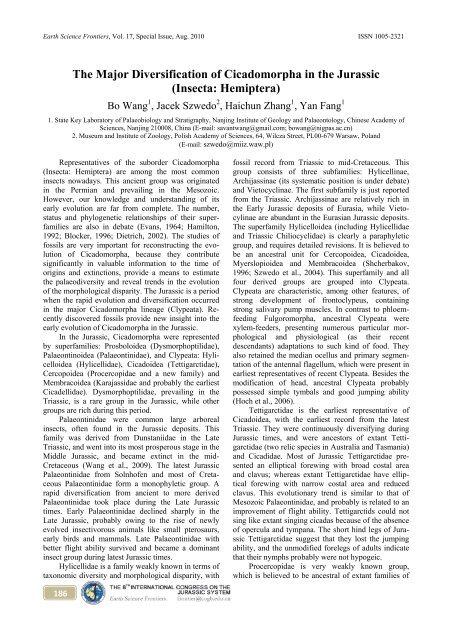in Jurassic and Cretaceous Stratigraphy
in Jurassic and Cretaceous Stratigraphy
in Jurassic and Cretaceous Stratigraphy
You also want an ePaper? Increase the reach of your titles
YUMPU automatically turns print PDFs into web optimized ePapers that Google loves.
Earth Science Frontiers, Vol. 17, Special Issue, Aug. 2010 ISSN 1005-2321<br />
186<br />
The Major Diversification of Cicadomorpha <strong>in</strong> the <strong>Jurassic</strong><br />
(Insecta: Hemiptera)<br />
Bo Wang 1 , Jacek Szwedo 2 , Haichun Zhang 1 , Yan Fang 1<br />
1. State Key Laboratory of Palaeobiology <strong>and</strong> <strong>Stratigraphy</strong>, Nanj<strong>in</strong>g Institute of Geology <strong>and</strong> Palaeontology, Ch<strong>in</strong>ese Academy of<br />
Sciences, Nanj<strong>in</strong>g 210008, Ch<strong>in</strong>a (E-mail: savantwang@gmail.com; bowang@nigpas.ac.cn)<br />
2. Museum <strong>and</strong> Institute of Zoology, Polish Academy of Sciences, 64, Wilcza Street, PL00-679 Warsaw, Pol<strong>and</strong><br />
(E-mail: szwedo@miiz.waw.pl)<br />
Representatives of the suborder Cicadomorpha<br />
(Insecta: Hemiptera) are among the most common<br />
<strong>in</strong>sects nowadays. This ancient group was orig<strong>in</strong>ated<br />
<strong>in</strong> the Permian <strong>and</strong> prevail<strong>in</strong>g <strong>in</strong> the Mesozoic.<br />
However, our knowledge <strong>and</strong> underst<strong>and</strong><strong>in</strong>g of its<br />
early evolution are far from complete. The number,<br />
status <strong>and</strong> phylogenetic relationships of their super-<br />
families are also <strong>in</strong> debate (Evans, 1964; Hamilton,<br />
1992; Blocker, 1996; Dietrich, 2002). The studies of<br />
fossils are very important for reconstruct<strong>in</strong>g the evo-<br />
lution of Cicadomorpha, because they contribute<br />
significantly <strong>in</strong> valuable <strong>in</strong>formation to the time of<br />
orig<strong>in</strong>s <strong>and</strong> ext<strong>in</strong>ctions, provide a means to estimate<br />
the palaeodiversity <strong>and</strong> reveal trends <strong>in</strong> the evolution<br />
of the morphological disparity. The <strong>Jurassic</strong> is a period<br />
when the rapid evolution <strong>and</strong> diversification occurred<br />
<strong>in</strong> the major Cicadomorpha l<strong>in</strong>eage (Clypeata). Re-<br />
cently discovered fossils provide new <strong>in</strong>sight <strong>in</strong>to the<br />
early evolution of Cicadomorpha <strong>in</strong> the <strong>Jurassic</strong>.<br />
In the <strong>Jurassic</strong>, Cicadomorpha were represented<br />
by superfamilies: Prosboloidea (Dysmorphoptilidae),<br />
Palaeont<strong>in</strong>oidea (Palaeont<strong>in</strong>idae), <strong>and</strong> Clypeata: Hyli-<br />
celloidea (Hylicellidae), Cicadoidea (Tettigarctidae),<br />
Cercopoidea (Procercopidae <strong>and</strong> a new family) <strong>and</strong><br />
Membracoidea (Karajassidae <strong>and</strong> probably the earliest<br />
Cicadellidae). Dysmorphoptilidae, prevail<strong>in</strong>g <strong>in</strong> the<br />
Triassic, is a rare group <strong>in</strong> the <strong>Jurassic</strong>, while other<br />
groups are rich dur<strong>in</strong>g this period.<br />
Palaeont<strong>in</strong>idae were common large arboreal<br />
<strong>in</strong>sects, often found <strong>in</strong> the <strong>Jurassic</strong> deposits. This<br />
family was derived from Dunstaniidae <strong>in</strong> the Late<br />
Triassic, <strong>and</strong> went <strong>in</strong>to its most prosperous stage <strong>in</strong> the<br />
Middle <strong>Jurassic</strong>, <strong>and</strong> became ext<strong>in</strong>ct <strong>in</strong> the mid-<br />
<strong>Cretaceous</strong> (Wang et al., 2009). The latest <strong>Jurassic</strong><br />
Palaeont<strong>in</strong>idae from Solnhofen <strong>and</strong> most of Creta-<br />
ceous Palaeont<strong>in</strong>idae form a monophyletic group. A<br />
rapid diversification from ancient to more derived<br />
Palaeont<strong>in</strong>idae took place dur<strong>in</strong>g the Late <strong>Jurassic</strong><br />
times. Early Palaeont<strong>in</strong>idae decl<strong>in</strong>ed sharply <strong>in</strong> the<br />
Late <strong>Jurassic</strong>, probably ow<strong>in</strong>g to the rise of newly<br />
evolved <strong>in</strong>sectivorous animals like small pterosaurs,<br />
early birds <strong>and</strong> mammals. Late Palaeont<strong>in</strong>idae with<br />
better flight ability survived <strong>and</strong> became a dom<strong>in</strong>ant<br />
<strong>in</strong>sect group dur<strong>in</strong>g latest <strong>Jurassic</strong> times.<br />
Hylicellidae is a family weakly known <strong>in</strong> terms of<br />
taxonomic diversity <strong>and</strong> morphological disparity, with<br />
fossil record from Triassic to mid-<strong>Cretaceous</strong>. This<br />
group consists of three subfamilies: Hylicell<strong>in</strong>ae,<br />
Archijass<strong>in</strong>ae (its systematic position is under debate)<br />
<strong>and</strong> Vietocycl<strong>in</strong>ae. The first subfamily is just reported<br />
from the Triassic. Archijass<strong>in</strong>ae are relatively rich <strong>in</strong><br />
the Early <strong>Jurassic</strong> deposits of Eurasia, while Vieto-<br />
cyl<strong>in</strong>ae are abundant <strong>in</strong> the Eurasian <strong>Jurassic</strong> deposits.<br />
The superfamily Hylicelloidea (<strong>in</strong>clud<strong>in</strong>g Hylicellidae<br />
<strong>and</strong> Triassic Chiliocyclidae) is clearly a paraphyletic<br />
group, <strong>and</strong> requires detailed revisions. It is believed to<br />
be an ancestral unit for Cercopoidea, Cicadoidea,<br />
Myerslopioidea <strong>and</strong> Membracoidea (Shcherbakov,<br />
1996; Szwedo et al., 2004). This superfamily <strong>and</strong> all<br />
four derived groups are grouped <strong>in</strong>to Clypeata.<br />
Clypeata are characteristic, among other features, of<br />
strong development of frontoclypeus, conta<strong>in</strong><strong>in</strong>g<br />
strong salivary pump muscles. In contrast to phloem-<br />
feed<strong>in</strong>g Fulgoromorpha, ancestral Clypeata were<br />
xylem-feeders, present<strong>in</strong>g numerous particular mor-<br />
phological <strong>and</strong> physiological (as their recent<br />
descendants) adaptations to such k<strong>in</strong>d of food. They<br />
also reta<strong>in</strong>ed the median ocellus <strong>and</strong> primary segmen-<br />
tation of the antennal flagellum, which were present <strong>in</strong><br />
earliest representatives of recent Clypeata. Besides the<br />
modification of head, ancestral Clypeata probably<br />
possessed simple tymbals <strong>and</strong> good jump<strong>in</strong>g ability<br />
(Hoch et al., 2006).<br />
Tettigarctidae is the earliest representative of<br />
Cicadoidea, with the earliest record from the latest<br />
Triassic. They were cont<strong>in</strong>uously diversify<strong>in</strong>g dur<strong>in</strong>g<br />
<strong>Jurassic</strong> times, <strong>and</strong> were ancestors of extant Tetti-<br />
garctidae (two relic species <strong>in</strong> Australia <strong>and</strong> Tasmania)<br />
<strong>and</strong> Cicadidae. Most of <strong>Jurassic</strong> Tettigarctidae pre-<br />
sented an elliptical forew<strong>in</strong>g with broad costal area<br />
<strong>and</strong> clavus; whereas extant Tettigarctidae have ellip-<br />
tical forew<strong>in</strong>g with narrow costal area <strong>and</strong> reduced<br />
clavus. This evolutionary trend is similar to that of<br />
Mesozoic Palaeont<strong>in</strong>idae, <strong>and</strong> probably is related to an<br />
improvement of flight ability. Tettigarctids could not<br />
s<strong>in</strong>g like extant s<strong>in</strong>g<strong>in</strong>g cicadas because of the absence<br />
of opercula <strong>and</strong> tympana. The short h<strong>in</strong>d legs of Jura-<br />
ssic Tettigarctidae suggest that they lost the jump<strong>in</strong>g<br />
ability, <strong>and</strong> the unmodified forelegs of adults <strong>in</strong>dicate<br />
that their nymphs probably were not hypogeic.<br />
Procercopidae is very weakly known group,<br />
which is believed to be ancestral of extant families of

















